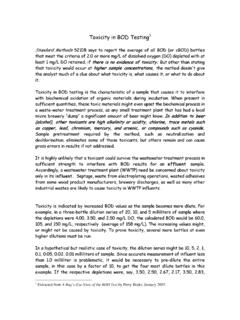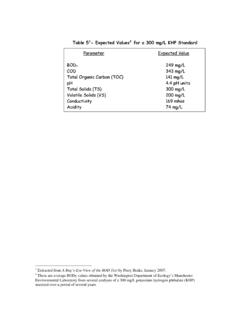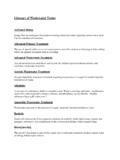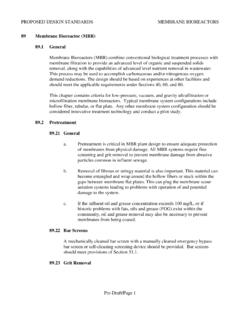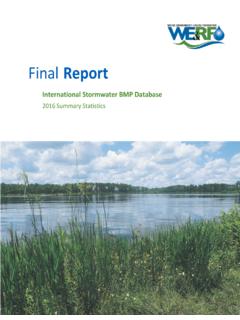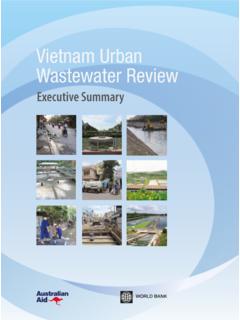Transcription of The Perfect Seed1 - perrybrake.com
1 The Perfect Seed1 What is the Perfect seed for the BOD test? That s that results in the glucose/glutamic acid (GGA) standard having an average BOD of 198 mg/L, and a standard deviation of zero. Obviously, the Perfect seed doesn t exist. So what makes a good BOD seed. Also an easy that gives an average close enough to 198 mg/L, with a low standard deviation indicating good precision. But that definition requires interpretation, and if the lab is doing carbonaceous BOD (CBOD) rather than BOD, it may not be the correct Standard Methods 5210B says that the glucose/glutamic acid (GGA) test is run to determine "seed effectiveness." In the 19th and earlier editions, it also said that the "DO uptake of seeded dilution water should be between and mg/L.
2 " That criterion was correctly removed in the 20th edition, and the GGA test is the only test of seed quality. Summarizing, the seed should result in an average GGA close enough to 198 mg/L,3 with a standard deviation of 10 mg/L4 or less, these values being derived from a nationwide study. What makes up such a seed, and where is it most likely found? The most important quality of a good seed is that it has a sufficient population of healthy, hungry bacteria. Many lab analysts/technicians equate this to having a high BOD. If you 1 Extracted from A Bug s-Eye-View of the BOD Test by Perry Brake, January 2007. 2 Because glutamic acid contains nitrogen, it will not be completely oxidized if nitrifiers are inhibited.
3 This makes the goal for carbonaceous BOD (CBOD) lower than for say 172 mg/L, some say even lower. If nitrifiers are not present in the seed, expect BOD and CBOD for GGA to be approximately lower than 198 mg/L. 3 Only the data a tell you what close enough means. 4 Actually, 5210B says the mg/L standard deviation attained in the nationwide study should be considered an action limit. Since action limits are three standard deviations, the goal for one standard deviation would be 10 mg/L or lower. Setting 10 mg/L as a goal for the standard deviation of repeated glucose/glutamic acid analyses was done without benefit of a study or, apparently, any other scientific input.
4 Although 10 mg/L and even lower is certainly achievable, the author, based on observation of the test being done in hundreds of labs, considers 10 mg/L it to be overly optimistic. The author suggests a standard deviation of 15 mg/L or lower as a reasonable precision goal. 1 are using a natural seed ( , one from wastewater), you want the seed material to have enough organic material (BOD) present to serve as food for the bacteria. If you are using a lyophilized (so called synthetic, artificial, or commercial) seed, the bacteria do not need food (until reconstituted), so one should not expect a high BOD for the seed control bottle. Another quality of a good seed is that it be consistent.
5 You don t want a seed that averages 198 mg/L for GGA, but bounces around from 120 mg/L in one batch to 266 in the next. So where is a consistent, healthy population of bacteria likely to be found? Standard Methods correctly states that one of the best sources is primary effluent from a domestic wastewater treatment plant (WWTP). Usually, such bacteria are consistently healthy and numerous. Perhaps second best in a domestic WWTP would be final effluent before disinfection where bacteria should be healthy, consistent, but not so perhaps from an oxidation ditch, or some other location in the plant. Many analysts opt for raw influent, probably mistakenly equating "high BOD" with "good seed.
6 " Raw influent is usually very inconsistent because of variable flow, seasonal fluctuations, local events such as a large fair ongoing in town, and other variables. Commercial labs and industrial wastewater dischargers not having a flow of domestic sewage running through their location have the choice of either using seed obtained from a local WWTP, or using a synthetic seed. If using the latter, one wants to consider if it is BOD, or CBOD, that is being reported. If it is BOD, a seed containing some nitrogenous bacteria (nitrifiers) should be used. If it is CBOD, it doesn t matter if nitrifiers are present in the seed or not since they would be inhibited. Some synthetic seeds contain nitrifiers, and some purposely do not.
7 Another caution when using synthetic Methods 5210B (in all approved editions) says to use enough seed in seeded samples to get a depletion of to mg/L from the seed. With synthetic seeds, this may require using so much seed that it becomes the major ingredient in the bottle. This would be counterproductive, and some regulators would argue that if the GGA results are good (little bias, good precision), it doesn t matter how much depletion the seed contributed. If using a synthetic seed, it is wise to start out by trying the manufacturer s preparation instructions. Quite often, the result will be a consistent, but weak seed that gives an average glucose/glutamic acid result well below 198 mg/L for BOD5.
8 Many labs have found better results after aerating the seed mixture overnight in the BOD incubator (or on a benchtop if the lab temperature is steady at approximately 20 C). A couple milliliters of glucose/ glutamic acid solution as nourishment for the overnight aeration might also help. 2 The final answer? Use a seed that makes your GGA come out where you, your boss, and your data user (usually a regulatory agency) are happy. Finding a bunch of bacteria that are healthy and hungry like the one on page 1 might be a step in the right direction. 3
